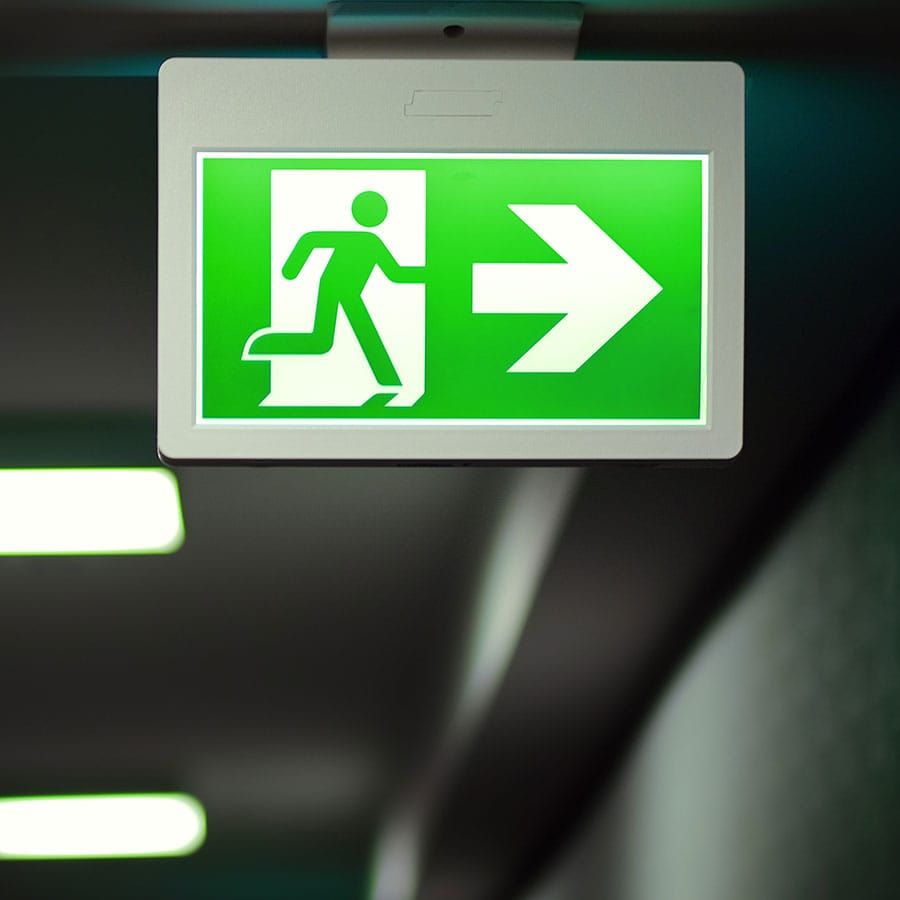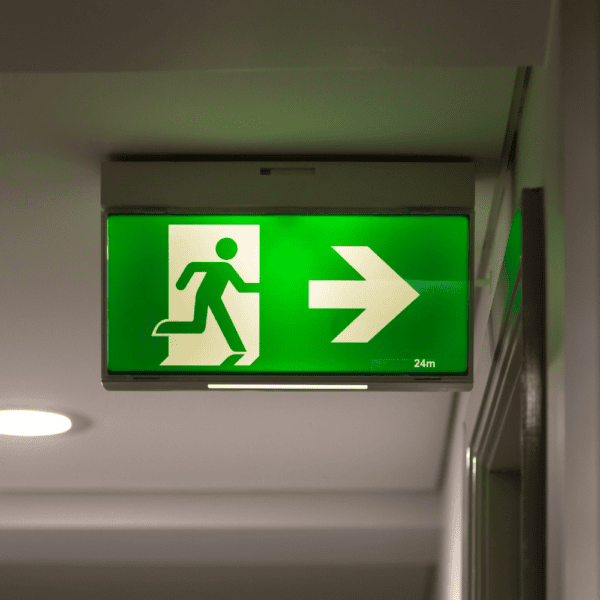Recently there has been a revision of the BSI guide to emergency lighting from Ian Watts, a UPS emergency lighting expert at KOHLER Uninterruptible Power.
In this article, we outline the key points in terms of correct emergency lighting choices.
Emergency lighting system selection
System requirement
While the major requirement of emergency lighting is to ensure that appropriate safety legislation is complied with, the systems also have other uses, and these should be taken into account when selecting the most appropriate system for a particular application.
The major requirement is normally to meet the legal requirement to prevent loss of life or injury when lighting fails, from hazards such as stairs, floor openings, obstructions and high inertia machinery, and to enable personnel to locate then use the escape routes safely. However, it also has a value in preventing financial loss due to theft, accidents, loss of process continuity and loss of working time. These considerations can influence the choice of the most appropriate system.
Examples of these applications that may be important to the user include: a sudden loss of light which creates conditions that encourage ‘opportunity theft’. This can determine the best location for the luminaires and the output from them while still fulfilling their safety function. Obvious areas that are at risk are cash in open tills and small size high value goods; these include gambling chips –for example on a roulette table. The appropriate illumination level tends to be higher than for the safety of the staff, but in all cases the speed of the illumination being provided is important. This favours maintained luminaires or high-power tungsten beam units. In addition, if the lighting failure has no accompanying problems, the operator and the occupants may want to conduct transactions on their way out. For example, a supermarket may wish to have adequate illumination over the checkouts. It will often be preferable for the store manager to check out customers rather than for them to leave their trolleys around the store requiring the staff to manually return the goods to stock.
Power source
Emergency lighting may be obtained from several types of system.
Electric storage battery systems
These are battery systems that charge from and monitor the mains supply and illuminating lamps in the event of supply failure. They are designed to provide specific finite duration and coverage of emergency lighting and they are the most widely accepted emergency lighting power source.
Advantages of storage battery systems:
- Almost instantaneous illumination is available. This is subject to the choice of luminaire and light source.
- They are physically compact, so little or no special space is required.
- Low cost for low power ranges.
- Low maintenance requirement and easy testing.
- It is possible to continuously monitor that the system is healthy.
Disadvantages of storage battery systems:
- The finite limited discharge duration has to be followed by a lengthy recharge period.
- Battery cost limitations make them suitable only for providing illumination for safety applications, not continuous power provision.
There are two major types. The first is self-contained where the luminaire contains its own battery and charger which power associated control gear and lamp in the event of a supply failure. The second is a central power supply system that can be used where a single large battery and charger which in a normal supply failure powers a wired distribution system with a number of slave remote luminaires.
Advantages of self-contained luminaires:
- They can be cheaply and quickly installed with minimum disturbance of the decor by using PVC cables in existing buildings.
- They are easy to wire so that they operate when the local lighting fails. (This is required for non-maintained fittings.)
- Systems can easily be extended by adding more single-point units (SPUs).
- The failure of one unit will not render the others inoperative.
- There are no system engineering considerations such as supply voltage drop calculations.
- They are often the only economic solution for small systems.
Disadvantages of self-contained luminaires:
- Non-maintained luminaires require operation of each final circuit to perform the monthly test.
- Some luminaires have a short battery life. Care is needed to use a fitting that will achieve the minimum design life of four years.
- Cell replacement is costly and time consuming.
- The electrical cost of charging multiple self-contained units is normally more than a single central power supply unit.
Central systems
Advantages of central systems:
- They allow control of the system as the maintained circuits can be locally or remotely switched and the output can be inhibited to prevent unwanted discharges when the premises are empty.
- The systems offer a choice of outputs so variable system durations can be supplied and load sharing by switched outputs can match the duration for specific areas to the application for safety lighting.
- They allow a wide choice of luminaires, including using unmodified normal mains luminaires.
NOTE These ‘unmodified’ luminaires must comply with the requirements of BS EN60598-2-22.
- The state of the power system can be monitored easily and automatically without the use of an automatic test system.
Disadvantages of central systems:
- They require a competent system engineer to design, install and service the system.
- Each luminaire or sub circuit must include devices to monitor the local lighting supply to the areas being protected unless operated in maintained mode.
- They cannot be easily extended; future expansion needs should be built into the initial design.
- They require fire protected segregated cabling distribution circuits.
Generator powered systems
A generator produces electricity to operate luminaires and is powered by petrol, diesel, gas or gas turbine motors. These are generally limited to uses where high-power outputs or long emergency lighting durations are required. The long start-up time is often in excess of the 5 s that is required for emergency lighting applications. Consequently, a separate battery powered system is also necessary to bridge the gap between supply failure and illumination being available from the generator.
Advantages of generator powered systems:
- The generators can operate indefinitely, subject only to the supply of fuel, and stoppages due to maintenance and breakdowns.
- They can use the existing mains fittings.
- They can power a variety of other loads as well as the lighting.
- Very high-power outputs may be obtained more cheaply than with any other system, enabling operation of the site to continue, hence providing standby as well as emergency operation.
Disadvantages of generator powered systems:
- There is usually a significant delay between mains failure and the generator reaching operating speed, which delays the availability of power, requiring battery systems to be used to bridge the time period until the illumination is available.
- The wiring must be in fire-resistant cable and each area must have luminaires fed directly from the normal supply while emergency supply from the generator or its bypass circuit must be connected to the luminaires in the event of a failure of the normal final lighting circuit.
- A separate area is required for the generator and fuel store.
- The stored fuel itself represents a fire hazard.
- The testing schedule required is to run the set monthly for one hour while supplying the majority of the load; after this the set must be refuelled to be ready for an emergency duty. The testing and servicing should be performed by specialist engineers.
- Noise and vibration cause disturbance and suppression is costly.
- If the generator fails, repairs can be lengthy, leaving the premises unprotected.
Typical applications
Generators are only normally used for standby duties where they provide an alternative to the normal mains supply, providing full illumination for as long as may be required. In applications like hospitals, essential areas such as operating theatres also need to have battery back-up systems to guard against cabling faults or starting problems with the generator. Other applications use large generators to enable activities to continue, combined with battery supplied luminaires to bridge the time gap while the generator starts and reaches operating speed and voltage output.
If you would like further information about emergency lighting systems, please contact us on [email protected] .
Author:
Ian Watts was co-opted onto the committee responsible for the drafting of BS.5266 part 1 in 2015, as the independent industry expert on new technology. As Business Development Manager for KOHLER Uninterruptible Power he has contributed to the drafting of BS.7273 part 6, a draft standard currently out for public comment to look at fire interface devices including the integration of dynamic emergency lighting systems. Sitting on the CEN 169 working group 3, tasked with this same development provides him with a European insight into this exciting market. He lectures for CIBSE and has been a trainer for the FIA since 2012.





